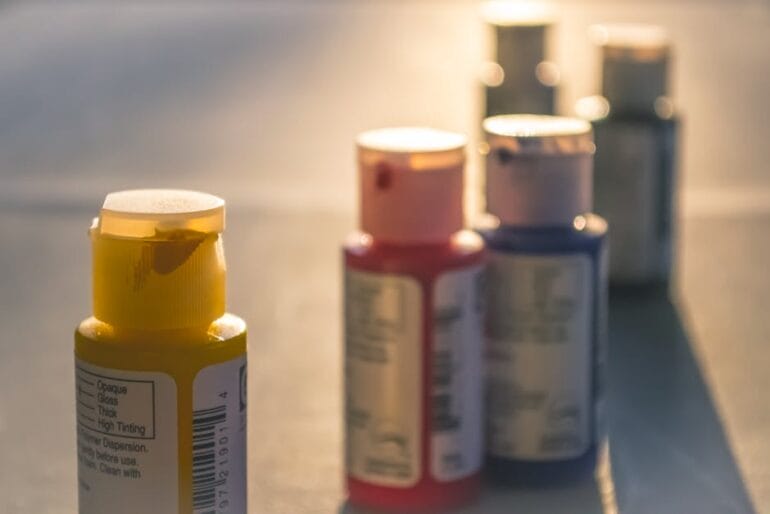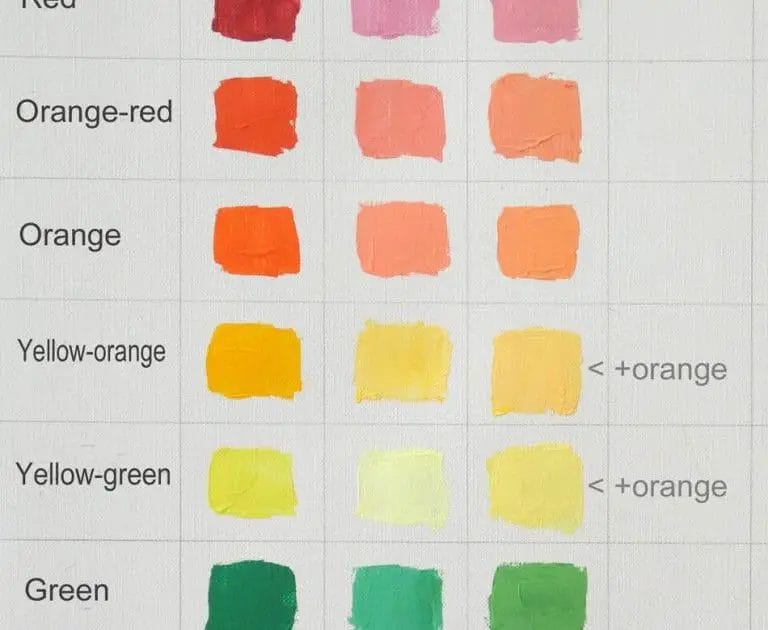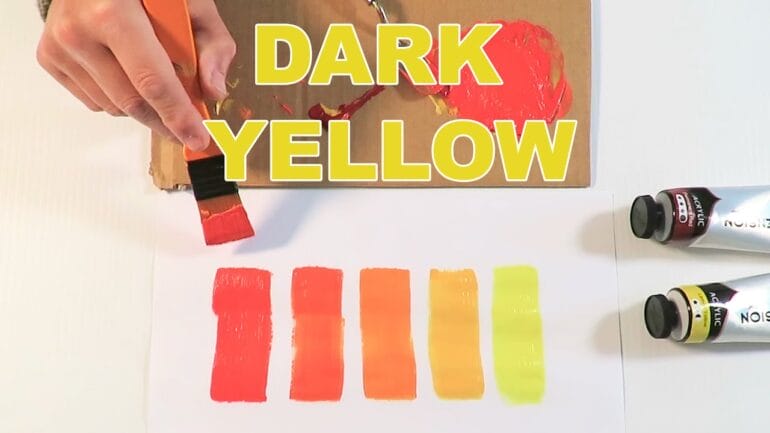Looking to create your own vibrant yellow acrylic paint? You’ve come to the right place! Making your own custom yellow acrylic paint is a fun and creative process that allows you to achieve the exact shade and consistency you desire.
Start by gathering your materials, including a high-quality yellow pigment, a binding medium like acrylic gel or medium, and a palette knife. Mix the pigment with the medium until you achieve the desired hue, adjusting the ratio as needed. Test the color on a small canvas or paper to ensure it matches your vision. Voila! You now have your very own homemade yellow acrylic paint.
Experimenting with homemade paints not only saves you money, but also gives your artwork a unique touch. So, get your creative juices flowing and enjoy the process of making your own yellow acrylic paint!

Essential Ingredients for Creating Yellow Acrylic Paint at Home
If you are an artist or enjoy painting as a hobby, you may be interested in creating your own yellow acrylic paint at home. Making your own paint not only gives you the freedom to customize the color but also allows you to experiment with different techniques and textures. In this section, we will explore the essential ingredients required to create yellow acrylic paint.
1. Pigments
The first and most crucial ingredient for creating yellow acrylic paint is the pigment. Pigments are finely ground colored powders that provide the color in paint. For yellow paint, you will need a yellow pigment that is lightfast and suitable for acrylics. Some popular yellow pigments include cadmium yellow, yellow ochre, and lemon yellow. You can choose the pigment based on the specific shade of yellow you want to achieve.
2. Binder
To transform the pigment into paint, you will need a binder. In the case of acrylic paint, the binder is an acrylic polymer emulsion. This binder helps the paint adhere to the surface and provides a smooth, flexible finish. You can purchase acrylic binders from art supply stores or online. Make sure to choose a binder that is compatible with acrylic pigments.
3. Solvents
While water is the primary solvent for acrylic paint, you may need additional solvents to achieve the desired consistency and texture. Depending on your preference, you can use various solvents such as acrylic flow improvers, retarders, or mediums. These solvents help thin the paint, extend its drying time, or enhance its flow. Experimentation is key to finding the right solvent for your paint mixture.
4. Mixing Tools
To create yellow acrylic paint, you will need suitable mixing tools. A palette knife or a plastic spatula can be used for combining the pigment and binder. Additionally, having a palette or a mixing surface will provide you with a space to blend and mix the ingredients. Make sure to clean your tools thoroughly after each use to avoid any cross-contamination of colors.
5. Containers
Having proper containers for storing and mixing your homemade acrylic paint is essential. Use airtight containers or small jars to store your paint for future use. Transparent containers are preferable as they allow you to see the color and consistency of your paint. It’s also a good idea to label your containers with the color name and the date of creation to keep track of your paint inventory.
6. Safety Precautions
When working with pigments and binders, it’s important to consider safety precautions. Some pigments may contain toxic substances, so wearing gloves, protective eyewear, and a mask is advisable. Ensure proper ventilation in your workspace to minimize the inhalation of any harmful fumes.
In summary, creating your own yellow acrylic paint can be a rewarding and personal experience. By gathering the essential ingredients, including pigments, binders, solvents, mixing tools, and containers, you can embark on a creative journey to produce vibrant yellow hues. Don’t forget to prioritize safety and enjoy the process of experimenting with different shades and techniques.

Step-by-step guide to making vibrant yellow acrylic paint
Acrylic paint is a versatile and popular medium used by artists of all skill levels. While it is readily available in a wide range of colors, sometimes you may want to create your own custom shades. In this section, we will provide you with a step-by-step guide on how to make vibrant yellow acrylic paint.Materials you will need:
– Acrylic paint in primary yellow – White acrylic paint – Palette or mixing surface – Mixing knife or palette knife – Paintbrush or spongeStep 1: Prepare your workspace
Before you begin, it’s important to set up a clean and organized workspace. Lay out all your materials and ensure that you have enough space to work comfortably.Step 2: Squeeze out primary yellow paint
Start by squeezing out the primary yellow acrylic paint onto your palette or mixing surface. Use an adequate amount depending on the quantity of paint you wish to create.Step 3: Gradually add white paint
Next, take a small amount of white acrylic paint and gradually add it to the yellow paint. Start with a 1:1 ratio, meaning equal parts yellow and white paint. Mix the two colors together thoroughly using a mixing knife or palette knife.Step 4: Assess the color
After mixing the yellow and white paints, assess the resulting color. If the shade is not vibrant enough for your liking, continue adding small amounts of white paint until you achieve the desired vibrancy. Remember to mix well after each addition to ensure an even color.Step 5: Test the color
Once you are satisfied with the hue, test the color on a piece of paper or canvas. Apply a small amount of the paint using a paintbrush or sponge. Assess how it appears when dry and compare it with your desired outcome. Make any necessary adjustments by adding additional yellow or white paint until you achieve the vibrancy you desire.Step 6: Store and label
If you have leftover paint, store it in an airtight container or tube for future use. Label the container with the color mixture and date to easily identify it later.Summary
By following this step-by-step guide, you can create your own vibrant yellow acrylic paint. Experimenting with custom colors allows you to add a personal touch to your artwork and opens up endless possibilities for creativity. Remember to clean your brushes and palette thoroughly after each use to maintain the quality and longevity of your paints.
Tips and Tricks for Achieving the Perfect Shade of Yellow in Your Homemade Acrylic Paint
Yellow is a vibrant and versatile color that can add warmth and brightness to any artwork. Whether you are a beginner or an experienced artist, creating your own homemade acrylic paint allows you to have more control over the color and texture of your artwork. In this section, we will explore some useful tips and tricks to help you achieve the perfect shade of yellow in your homemade acrylic paint.
1. Start with a Base Color
Before you begin mixing your yellow paint, it is helpful to start with a base color. Choose a white or light-colored paint as your base to achieve a brighter and more vibrant yellow. This will optimize the intensity of the yellow pigment and make it stand out.
2. Use High-Quality Pigments
The quality of the pigments you use plays a significant role in the final color of your paint. To achieve a rich and vibrant yellow, opt for high-quality yellow pigments. These pigments have better saturation and lightfastness, ensuring that the color remains true over time.
3. Mix Primary Colors
If you don’t have a pre-made yellow pigment, you can create your own by mixing primary colors. Start by mixing equal parts of red and green paint to create a shade of brown. Then, add a small amount of white paint to the brown mixture, gradually lightening it until you achieve the desired shade of yellow. This method allows you to customize your yellow color to suit your preferences.
4. Experiment with Different Ratios
To achieve different shades of yellow, experiment with different ratios of yellow to white paint. Adding more white paint will create a lighter and softer yellow, while adding less white paint will result in a more intense and vibrant shade. Play around with different ratios until you find the perfect balance.
5. Consider Complementary Colors
Complementary colors can enhance the vibrancy of your yellow paint. For a warmer yellow, add a touch of red paint to your mixture. Conversely, for a cooler yellow, incorporate a small amount of blue paint. Be cautious when using complementary colors, as a little can go a long way.
6. Test the Color
Always test the color of your homemade yellow paint before applying it to your artwork. Paint a small swatch on a piece of paper or canvas to see how the color appears when dry. This allows you to make any necessary adjustments to achieve your desired shade of yellow.
7. Thin or Thicken the Paint
The consistency of your homemade yellow paint can also impact the overall color. If you want a more transparent and lighter yellow, add a small amount of water or acrylic medium to thin the paint. Conversely, if you desire a thicker and more opaque yellow, avoid adding too much water or use a thicker medium.
8. Mix Well
To ensure an even distribution of pigments in your paint, mix the colors thoroughly. Use a palette knife or a brush to blend the pigments together until you achieve a smooth and consistent yellow color. This step is crucial in achieving an accurate shade of yellow without any streaks or uneven patches.
9. Take Note of Drying Time
Yellow pigments tend to undergo some changes as they dry. The color may become slightly darker or more intense after the paint has dried completely. Keep this in mind when mixing your yellow paint and allow it to dry fully before evaluating the final color.
10. Keep a Record
Lastly, it is helpful to keep a record of the ratios and techniques you use to create your desired shade of yellow. This allows you to replicate the color in future projects and saves you time and effort in the long run.
In summary, achieving the perfect shade of yellow in your homemade acrylic paint requires a combination of quality pigments, experimentation with ratios and complementary colors, thorough mixing, and careful evaluation. By following these tips and tricks, you can create a vibrant and personalized yellow paint that will enhance your artwork.
Common Mistakes to Avoid When Making Yellow Acrylic Paint at Home
Acrylic paint is a popular choice among artists due to its versatility and vibrant colors. Making your own acrylic paint at home can be a rewarding experience, allowing you to create custom colors and save money in the process. However, there are some common mistakes that people often make when attempting to make yellow acrylic paint. In this section, we will explore these mistakes and provide tips on how to avoid them.
1. Using Low-Quality Pigments
One of the most common mistakes when making yellow acrylic paint is using low-quality pigments. The quality of the pigment you use will greatly affect the brightness, longevity, and overall appearance of the paint. It is important to invest in high-quality pigments to achieve the desired yellow color.
When purchasing pigments, look for those specifically made for acrylic paints. These pigments are finely ground and have a higher lightfastness rating, ensuring that your yellow paint will not fade over time.
2. Incorrect Mixing Ratios
The proportions of the ingredients used when making yellow acrylic paint are crucial for achieving the desired color. It is important to follow the proper mixing ratios to ensure a consistent and vibrant yellow hue.
Typically, the ratio for mixing acrylic paint is 1 part pigment to 2 parts binder. However, the exact ratio may vary depending on the specific brand or type of pigment you are using. It is always recommended to refer to the instructions provided by the pigment manufacturer.
3. Insufficient Mixing Time
Another common mistake is not adequately mixing the pigment and binder. It is essential to thoroughly mix the ingredients to achieve a smooth and uniform consistency.
Use a palette knife or a wooden spatula to blend the pigment and binder together. Mix in a circular motion, ensuring that there are no lumps or streaks in the paint. Take your time during this step to ensure that the pigment is fully incorporated.
4. Ignoring the Drying Time
Allowing proper drying time is crucial when making yellow acrylic paint. Rushing the drying process can result in a subpar paint consistency and poor color saturation.
After mixing the pigment and binder, it is recommended to let the paint sit for at least 24 hours before using it. This will allow the paint to fully cure and reach its optimal color intensity. Patience is key when it comes to creating high-quality yellow acrylic paint.
5. Storing the Paint Improperly
How you store your homemade yellow acrylic paint can also impact its longevity and quality. Exposure to air, light, and extreme temperatures can cause the paint to dry out or become discolored.
It is best to store your paint in airtight containers or tubes. Ensure that the containers are sealed properly to prevent air from entering. Additionally, store the paint in a cool, dry place away from direct sunlight to maintain its freshness and color.
In summary, making yellow acrylic paint at home can be a rewarding activity for artists. By avoiding common mistakes such as using low-quality pigments, incorrect mixing ratios, insufficient mixing time, ignoring the drying time, and improper storage, you can create vibrant and long-lasting yellow acrylic paint. Remember to always follow the instructions provided by the pigment manufacturer for the best results. Happy painting!
FAQs
1. How can I make yellow acrylic paint?
To make yellow acrylic paint, start with a base of white acrylic paint and gradually mix in small amounts of cadmium yellow paint until you achieve the desired shade of yellow. Remember to mix the paint thoroughly to ensure an even color. You can also experiment with adding other colors, such as a touch of red or orange, to create different shades of yellow.
2. What do I do if my yellow acrylic paint is too dark?
If your yellow acrylic paint is too dark, you can lighten it by adding small amounts of white acrylic paint to the mix. Start with just a little bit of white paint and gradually add more until you achieve the desired lighter shade of yellow. Remember to mix the paint thoroughly to ensure an even color.
3. How can I make a brighter shade of yellow with my acrylic paint?
To make a brighter shade of yellow with your acrylic paint, you can add a small amount of lemon yellow or primary yellow paint to your base yellow color. These brighter yellows have a higher pigment concentration and can help you achieve a more vibrant yellow hue. Experiment with different ratios to find the level of brightness you desire.
Conclusion
In conclusion, creating your own yellow acrylic paint is a rewarding and cost-effective way to add a vibrant touch to your artistic projects. By following a few simple steps and using readily available materials, you can effortlessly mix a custom shade of yellow that suits your creative vision. Whether you prefer a sunny lemon yellow or a deep golden hue, experimenting with different pigment combinations and ratios allows you to achieve the desired result. So, unleash your creativity and dive into the world of homemade yellow acrylic paint to elevate your artwork with a personalized touch. Happy painting!
